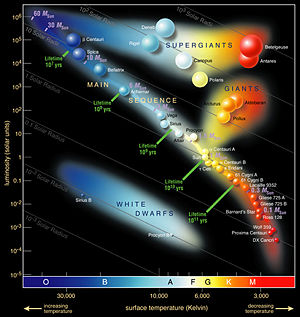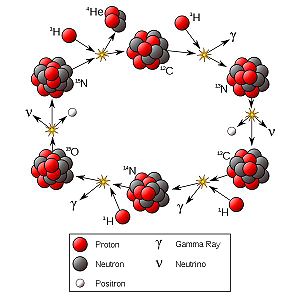7th Week: Stellar Structure and Evolution B: Difference between revisions
| Line 39: | Line 39: | ||
===CNO cycle=== | ===CNO cycle=== | ||
[[Image:CNO.jpg|thumb|300px|CNO cycle]] | |||
When stars contain heavier nuclides, in particular C, N and O | |||
Revision as of 00:22, 20 March 2009
Stellar properties
Hertzsprung-Russell Diagram
Its a diagram generated by plotting the luminosity of the stars against their temperature at the surface. Here luminosity is the amount of energy a body radiates per unit time. This quantity is often measured in solar luminosities. One solar luminosity is equal to W.
Stellar evolution
All stable stars maintain a balance between the force of gravity and the internal pressure, preventing them from collapsing. In stellar plasma there are several reaction networks. The reactions with the smallest Coulomb barrier take place in the shortest time and are responsible for most of the nuclear energy generation.
Hydrostatic hydrogen burning
Hydrogen burning produces more energy than any other fuel consumed in stars. This form of burning is also highly favored for young stars as they consist mostly of hydrogen. Also, this burning stage marks the star as a main sequence star.
pp chain
The pp chain is the process by which protons undergo fusion to helium. This chain actually comes in three forms but is dominated mostly by the ppI chain. This process occurs in three steps. The first is the fusion of two protons to form deuterium. Naturally one would assume that the two protons would form helium-2 but this is not within the drip-line. The logical next step would be to fuse two deuterium into helium-4, but this is unfavorable as the deuterium concentrations are low. So the next step is fusing a proton and deuterium. The final step is two fuse two helium-3 atoms into beryllium-6 which immediately decays to helium-4 and two protons. This can be summed up as:
The pp2 and pp3 chains are catalyst induced branches of helium-4 production. pp2 begins at the helium-3 reaction. It looks like:
pp3 chain begins after the helium-3 and helium-4 reaction of the pp2 chain.
CNO cycle
When stars contain heavier nuclides, in particular C, N and O











